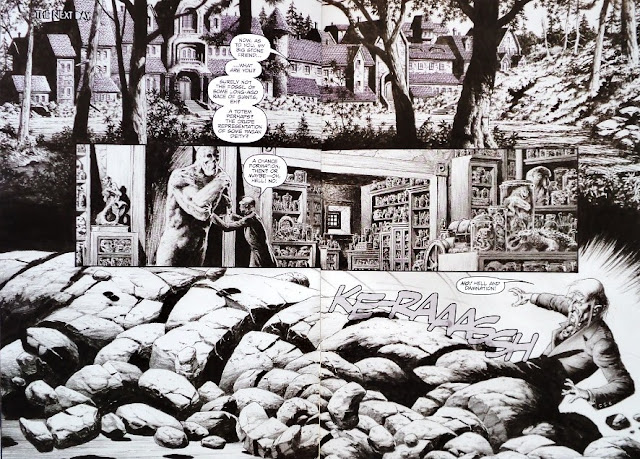With a good sense of humor and very amusing concepts, Niles and Wrightson revisited some of the classic elements of conventional horror stories, tweaking them when necessary. For starters, Doc Macabre, the protagonist, isn’t the typical hero you’d see in a supernatural saga. Doc Macabre is a 15-year-old kid, braver than anyone else, and he’s a boy genius too. He’s smart and a bit naive at times, he makes mistakes, but he’s never afraid to get back on track and come up with a solution to the problem at hand.
Doc Macabre shares a few similitudes with franchises like “Ghost Busters”, except that instead of a group of middle-aged man, disenchanted with the world, we have an enthusiastic teenager, full of ideas and inventions to capture ghosts, neutralize vampires and kick zombies ass. But at the same time he’s a pragmatic youngster, so obviously he charges for his services.
Lighthearted adventures, likeable characters and funny moments are the essence of Doc Macabre. In addition to the protagonist, we also get to meet Lloyd, a robot designed and built by the kid, a robot with a sparkling personality and completely faithful to its young master. Then we also have Detective Cooper (a private investigator who has recently returned from the grave) and the Ghoul, a creature similar to Frankenstein (let’s remember that Wrightson is a huge fan of Mary W. Shelley’s novel, adapting it as an amazing ongoing series titled Frankenstein Alive, Alive).
Steve Niles’ script is solid and, like I said before, I actually laughed out loud a couple of times while reading Doc Macabre. However, the main reason I bought this miniseries was because of legendary artist Bernie Wrightson. With highly revered runs in Creepy or Swamp Thing, to name just a few, Wrightson has been one of the most important artists in the American industry for decades. So I knew I couldn’t resist the urge of checking out his current output. And I have to say I’m glad I did.
________________________________________________________________________________________________
________________________________________________________________________________________________
Aunque me encantan las películas (o los cómics) de terror, siempre es refrescante encontrar una buena parodia como “Doc Macabre”. Ciertamente, Bernie Wrightson es considerado como el maestro indiscutible del cómic de terror, pero en el 2010 decidió colaborar con Steve Niles (famoso por títulos como "30 Days of Night", una magnífica reinterpretación del subgénero vampírico). Niles y Wrightson le dieron la espalda al suspenso y al gore, y asumieron un enfoque cómico en “Doc Macabre” (una miniserie de 3 ejemplares editada por IDW, desde diciembre del 2010 a febrero del 2011).
 |
| Science versus zombies / ciencia versus zombis |
 |
| Doc Macabre & Lloyd |
Aventuras desenfadadas, simpáticos personajes y momentos divertidos son la esencia de Doc Macabre. Además del protagonista, también conoceremos a Lloyd, un robot diseñado y construido por el muchacho, un robot con una chispeante personalidad y completamente fiel a su joven amo. Además, tenemos al detective Cooper (un investigador privado que ha regresado recientemente del más allá) y al Ghoul, una criatura similar a Frankenstein (recordemos que Wrightson es un gran fan de la novela de Mary W. Shelley, y ha hecho una asombrosa adaptación titulada Frankenstein Alive, Alive).
 |
| Ghoul & Detective Cooper |







